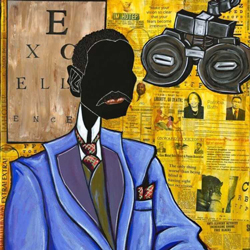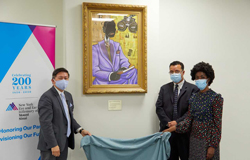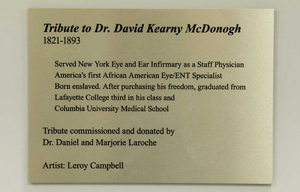
Commissioned painting of Dr. David Kearny McDonogh, a former slave who became the country’s first African American eye and ear specialist at New York Eye and Ear Infirmary of Mount Sinai (NYEE). Artist: Leroy Campbell.
Credit: NYEE
|
New York Eye and Ear Infirmary of Mount Sinai (NYEE) held a socially distant dedication ceremony on August 13 for Dr. David Kearny McDonogh, a pioneering Black physician who fought racial injustice in the 19th century to become the country’s first Black ophthalmology and otolaryngology specialist. Dr. McDonogh practiced at NYEE for more than a decade, paving the way for racial equity at the hospital, and became an activist in the abolitionist movement and a champion of workers’ rights, equality, and providing health care for all.
Dr. McDonogh’s accomplishments are remarkable, given the era in which he lived. But what makes them even more extraordinary is the fact that he started life as a slave.
Dr. McDonogh was born in 1821 in New Orleans, and his owner, impressed with his intelligence and fortitude, sent him north to attend college, according to NYEE. Dr. McDonogh went on to fight the racial prejudices of his time to accomplish his goal of practicing medicine. After becoming the first Black person to graduate from a college in Pennsylvania—finishing third in his class at Lafayette College, where he was forced to eat and study separately from the other students—Dr. McDonogh was rejected because of his race from every medical school he applied to.
John Kearny Rodgers, a founder of NYEE whom Dr. McDonogh met in college, became a mentor and helped him unofficially attend classes at Columbia College of Physicians and Surgeons (now part of Columbia University), but in 1847, when he would have graduated, the school refused to award him his medical degree. Dr. Rodgers continued to support him and Dr. McDonogh served on NYEE’s staff as a specialist for 11 years, focusing mostly on treating eye diseases. When Dr. Rodgers died in 1850, Dr. McDonogh took “Kearny” as his middle name to honor the man who helped him achieve success despite racial barriers.

(L to R) Dr. James Tsai, president New York Eye and Ear Infirmary of Mount Sinai, Dr. Daniel Laroche and Dr. Tamiesha Frempong, ophthalmologists at NYEE, with commissioned painting of Dr. David Kearny McDonogh at the 200th anniversary celebration. Credit: NYEE
|
In 2018, Richard Koplin, MD, a cornea surgeon at NYEE, led a vigorous and successful campaign to have Dr. McDonogh’s medical diploma injustice rectified, and Dr. McDonogh’s great-great-granddaughter accepted the posthumous degree on his behalf.
At the Aug. 13 ceremony, which kicked off NYEE’s 200th anniversary, hospital officials unveiled a painting of Dr. McDonogh which is on permanent display in the new waiting room to honor his legacy and contributions to the hospital. Daniel Laroche, MD, and his wife Marjorie commissioned and donated the artwork, created by artist Leroy Campbell.
“Dr. David Kearny McDonogh is an American hero who devoted his life to academic and medical excellence and helped to integrate colleges, medical schools, and health care and provide health care to all. This is an important legacy to help make the United States a more just and perfect union and an important part of American history,” explained Dr. Laroche, assistant clinical professor of ophthalmology at the Icahn School of Medicine at Mount Sinai and a cataract and glaucoma surgeon at NYEE.
“It is easy to simply say that Dr. David McDonogh overcame the racial prejudices of his time,” commented Dr. Koplin, clinical professor of ophthalmology at the Icahn School of Medicine at Mount Sinai. “Although true, this does not do justice to his accomplishments. Dr. McDonogh represents a sincere example to men and woman of color who aspire—and deserve—to become accomplished citizens of the American experiment.”

Plaque at New York Eye and Ear Infirmary of Mount Sinai honoring Dr. David Kearny McDonogh. Credit: NYEE
|
Founded by Dr. Rodgers and Edward Delafield, NYEE opened its doors on Aug. 14, 1820, becoming the first specialty hospital in North America. A charitable institution dedicated to serving vulnerable populations who were unable to afford medical treatment, NYEE quickly established a legacy of innovation in the delivery of care, starting that same year with the first successful cataract surgeries in the U. S., which restored sight to three pediatric patients.
“From its humble beginnings as a small clinic at 45 Chatham Square, NYEE has grown into a network of satellite practices serving the New York metropolitan area, and has become a model for delivering care to patients with diseases of the eyes, ears, nose, and throat,” said James C. Tsai, MD, MBA, president of NYEE. “We are at the forefront of innovative surgical specialty services and we are a clinical site for breakthrough translational research, pioneering many novel diagnostic and surgical techniques.”